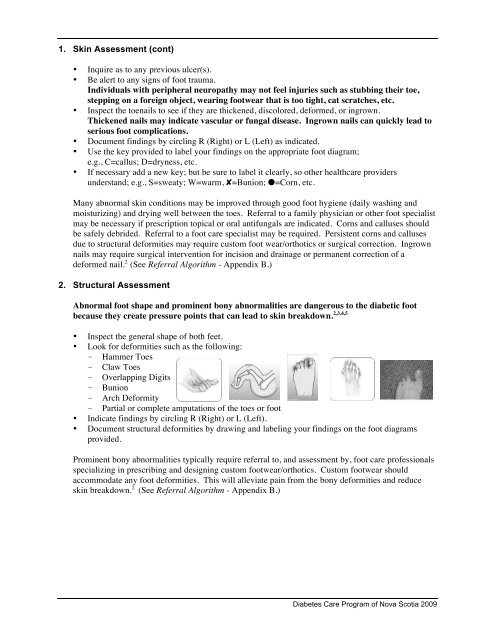Diabetes Care Program of Nova Scotia Foot Risk Assessment Form ...
Diabetes Care Program of Nova Scotia Foot Risk Assessment Form ...
Diabetes Care Program of Nova Scotia Foot Risk Assessment Form ...
Create successful ePaper yourself
Turn your PDF publications into a flip-book with our unique Google optimized e-Paper software.
1. Skin <strong>Assessment</strong> (cont)• Inquire as to any previous ulcer(s).• Be alert to any signs <strong>of</strong> foot trauma.Individuals with peripheral neuropathy may not feel injuries such as stubbing their toe,stepping on a foreign object, wearing footwear that is too tight, cat scratches, etc.• Inspect the toenails to see if they are thickened, discolored, deformed, or ingrown.Thickened nails may indicate vascular or fungal disease. Ingrown nails can quickly lead toserious foot complications.• Document findings by circling R (Right) or L (Left) as indicated.• Use the key provided to label your findings on the appropriate foot diagram;e.g., C=callus; D=dryness, etc.• If necessary add a new key; but be sure to label it clearly, so other healthcare providersunderstand; e.g., S=sweaty; W=warm, ✘=Bunion; ●=Corn, etc.Many abnormal skin conditions may be improved through good foot hygiene (daily washing andmoisturizing) and drying well between the toes. Referral to a family physician or other foot specialistmay be necessary if prescription topical or oral antifungals are indicated. Corns and calluses shouldbe safely debrided. Referral to a foot care specialist may be required. Persistent corns and callusesdue to structural deformities may require custom foot wear/orthotics or surgical correction. Ingrownnails may require surgical intervention for incision and drainage or permanent correction <strong>of</strong> adeformed nail. 2 (See Referral Algorithm - Appendix B.)2. Structural <strong>Assessment</strong>Abnormal foot shape and prominent bony abnormalities are dangerous to the diabetic footbecause they create pressure points that can lead to skin breakdown. 2,3,4,5• Inspect the general shape <strong>of</strong> both feet.• Look for deformities such as the following:– Hammer Toes– Claw Toes– Overlapping Digits– Bunion– Arch Deformity– Partial or complete amputations <strong>of</strong> the toes or foot• Indicate findings by circling R (Right) or L (Left).• Document structural deformities by drawing and labeling your findings on the foot diagramsprovided.Prominent bony abnormalities typically require referral to, and assessment by, foot care pr<strong>of</strong>essionalsspecializing in prescribing and designing custom footwear/orthotics. Custom footwear shouldaccommodate any foot deformities. This will alleviate pain from the bony deformities and reduceskin breakdown. 2 (See Referral Algorithm - Appendix B.)<strong>Diabetes</strong> <strong>Care</strong> <strong>Program</strong> <strong>of</strong> <strong>Nova</strong> <strong>Scotia</strong> 2009
















